Mad Max: Fury Road
7.8 /10 5 Votes
98% Rotten Tomatoes 8.7/10 Letterboxd Genre Action, Adventure, Sci-Fi Film series Mad Max Duration Country AustraliaUnited States | 8.4/10 IMDb 89% Metacritic Director George Miller Release date May 15, 2015 (India) Music director Junkie XL Language English | |||||||||||||||||||||||||||||||||
 | ||||||||||||||||||||||||||||||||||
Release date 7 May 2015 (2015-05-07) (TCL Chinese Theatre)14 May 2015 (2015-05-14) (Australia)15 May 2015 (2015-05-15) (United States) Cast (Max Rockatansky), (Imperator Furiosa), (Immortan Joe), (Nux), (Slit), (The Splendid Angharad) Similar movies Jurassic World , The Hunger Games: Catching Fire , Blackhat , Salt , Southland Tales , Red Hill Tagline What a Lovely Day. | ||||||||||||||||||||||||||||||||||
Mad max fury road official main trailer hd
Mad Max: Fury Road is a 2015 action film co-written, co-produced and directed by George Miller. Miller collaborated with Brendan McCarthy and Nico Lathouris on the screenplay. The fourth installment and a reboot of the Mad Max franchise, it is an Australian and American venture produced by Kennedy Miller Mitchell, RatPac-Dune Entertainment and Village Roadshow Pictures. The film is set in a future desert wasteland where gasoline and water are scarce commodities. It follows Max Rockatansky (Tom Hardy), who joins forces with Imperator Furiosa (Charlize Theron) to flee from cult leader Immortan Joe (Hugh Keays-Byrne) and his army in an armoured tanker truck, which leads to a lengthy road battle. The film also features Nicholas Hoult, Rosie Huntington-Whiteley, Riley Keough, Zoë Kravitz, Abbey Lee, and Courtney Eaton.
Contents
- Mad max fury road official main trailer hd
- Mad max fury road official retaliate trailer 2015 charlize theron tom hardy movie hd
- Plot
- Survival
- Other themes
- Feminism
- Development
- Filming
- Post production
- Music
- Release
- Prequel comics
- Home media
- Box office
- Critical reception
- Accolades
- Sequels
- References
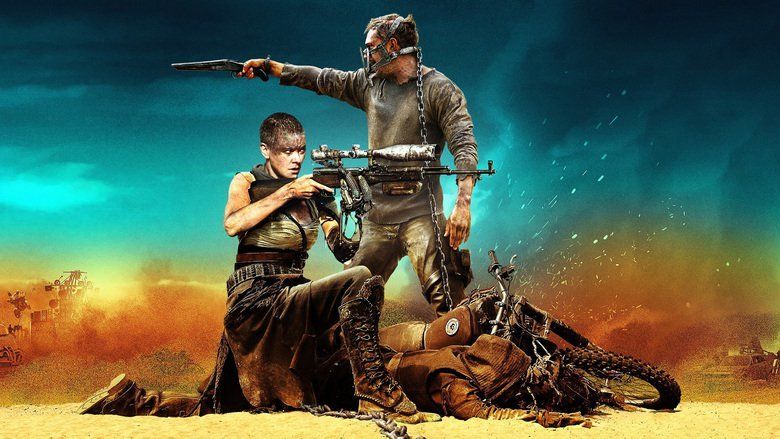
Fury Road was in development hell for many years, with pre-production starting as early as 1997. Attempts were made to shoot the film in 2001 and 2003, but were delayed due to the September 11 attacks and the Iraq War. In 2007, after focusing on Happy Feet, Miller decided to pursue producing the film again. He briefly considered producing it as a computer-animated film but abandoned it in favor of live-action. In 2009, Miller announced that filming would begin in early 2011. Hardy was cast as Max in June 2010, with production planned to begin that November. Principal photography was delayed several more times before beginning in July 2012. The film wrapped in December 2012, although additional film footage was shot in November 2013.
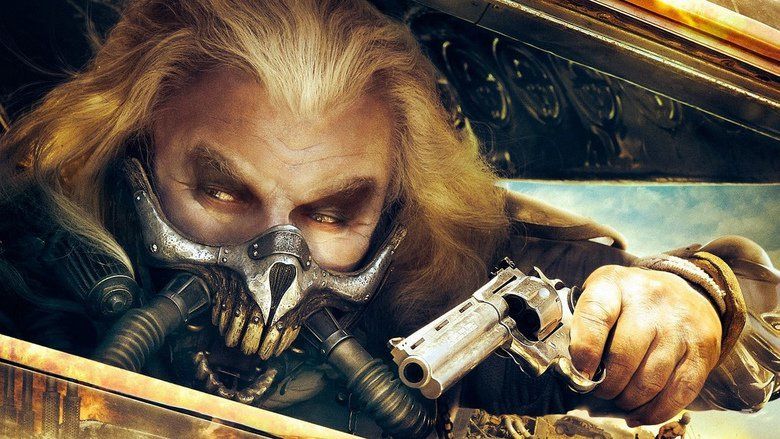
The film had its world premiere on 7 May 2015 at the TCL Chinese Theatre. It began a worldwide theatrical release on 14 May 2015, including an out-of-competition screening at the 68th Cannes Film Festival, in 2D, 3D, IMAX 3D and 4DX. It has grossed over $378 million worldwide, making it the highest-grossing film in the Mad Max franchise. The film was ranked by many critics as the best film of 2015, and is considered one of the greatest action films ever made; acclaim went to its screenplay, action sequences, and ensemble cast. Fury Road won multiple critical and guild awards, and received ten Academy Award nominations including Best Picture and Best Director for George Miller. It won six: Costume Design, Production Design, Makeup and Hairstyling, Film Editing, Sound Editing and Sound Mixing.
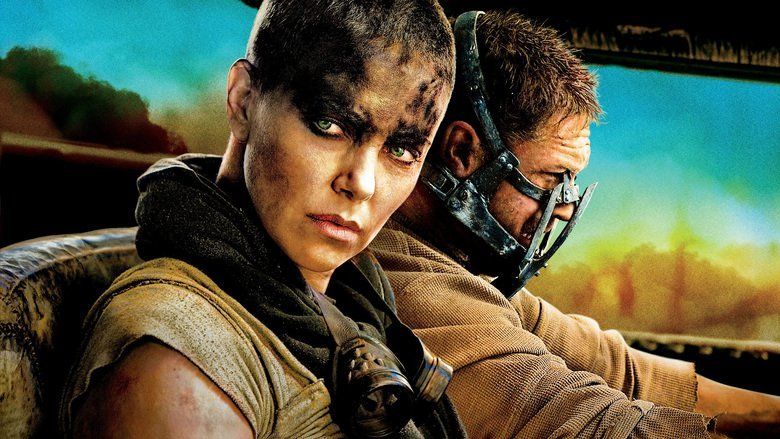
Mad max fury road official retaliate trailer 2015 charlize theron tom hardy movie hd
Plot
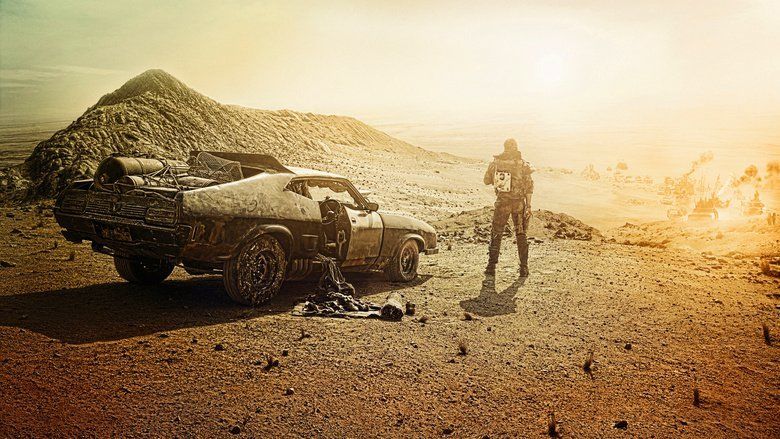
Following a nuclear holocaust, the world has become a desert wasteland and civilization has collapsed. Max Rockatansky, a survivor, is captured by the War Boys, the army of the tyrannical Immortan Joe, and taken to Joe's Citadel. Designated a universal blood donor, Max is imprisoned and used as a "blood bag" for a sick War Boy called Nux. Meanwhile, Imperator Furiosa, one of Joe's lieutenants, is sent in her armoured semi-truck, the "War Rig", to collect gasoline. When she drives off-route, Joe realizes that his five wives—women selected for breeding—are missing. Joe leads his entire army in pursuit of Furiosa, calling on the aid of nearby Gas Town and the Bullet Farm.
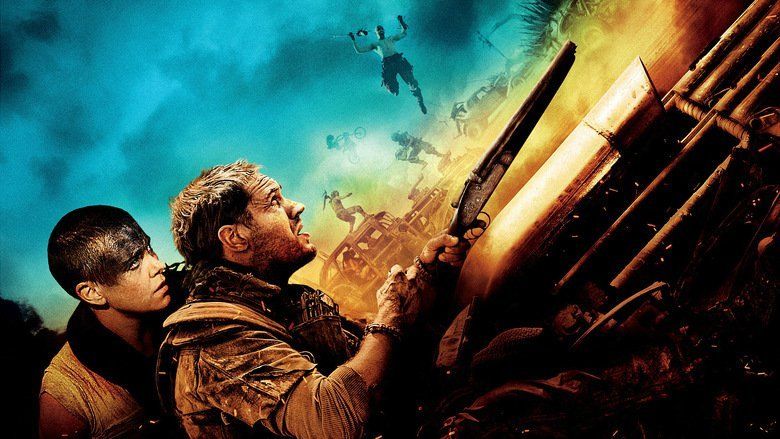
Nux joins the pursuit with Max strapped to his car to continue supplying blood. A battle ensues between the War Rig and Joe's forces. Furiosa drives into a sand storm, evading her pursuers, except Nux, who attempts to sacrifice himself to destroy the Rig. Max escapes and restrains Nux, but the car is destroyed. After the storm, Max finds Furiosa repairing the Rig, accompanied by the wives: Capable, Cheedo, Toast, the Dag and the Splendid Angharad, who is heavily pregnant with Joe's child. Max steals the Rig, but its kill switch disables it. Max reluctantly agrees to let Furiosa and the wives accompany him; Nux climbs on the Rig as it leaves and attempts to kill Furiosa, but is overcome and thrown out, and is picked up by Joe's army.
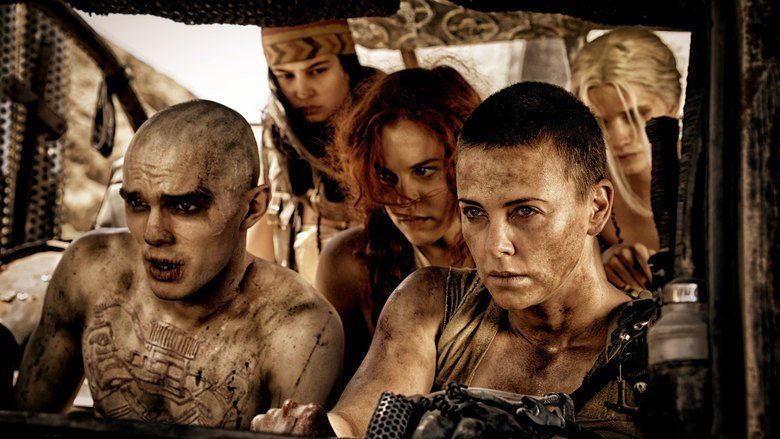
Furiosa drives through a biker gang-controlled canyon to barter a deal for safe passage. However, with Joe's forces pursuing, the gang turns on her, forcing her and the group to flee, while the bikers detonate the canyon walls to block Joe. Max and Furiosa fight pursuing bikers as Joe's car, with Nux now on board, breaks through the blockade and eventually attacks the War Rig, allowing Nux to board. However, as the Rig escapes, Angharad falls off in an attempt to protect Max and is run over by Joe's car, killing her and her child. Furiosa explains to Max that they are escaping to the "Green Place", an idyllic land she remembers from her childhood. Capable finds Nux hiding in the Rig, distraught over his failure, and consoles him. That night, the Rig gets stuck in the mud. Furiosa and Max slow Joe's forces with mines, but Joe's ally, the Bullet Farmer, continues pursuing them. Nux helps Max free the Rig while Furiosa shoots and blinds the Bullet Farmer. Max walks into the dark to confront the Bullet Farmer and his men, returning with guns and ammunition.

They drive the War Rig overnight through swampland and desert, coming across a naked woman the next day. Max suspects a trap, though Furiosa approaches the woman and states her history and clan affiliation. The naked woman summons her clan, the Vuvalini, who recognize Furiosa as one of their own who was kidnapped as a child. Furiosa is devastated to learn that the swampland they passed was indeed the Green Place, now uninhabitable. The group then plans to ride motorbikes across immense salt flats in the hope of finding a new home. Max chooses to stay behind, but after seeing visions of a child he failed to save, he convinces them to return to the undefended Citadel, which has ample water and greenery that Joe keeps for himself, and trap Joe and his army in the bikers' canyon.
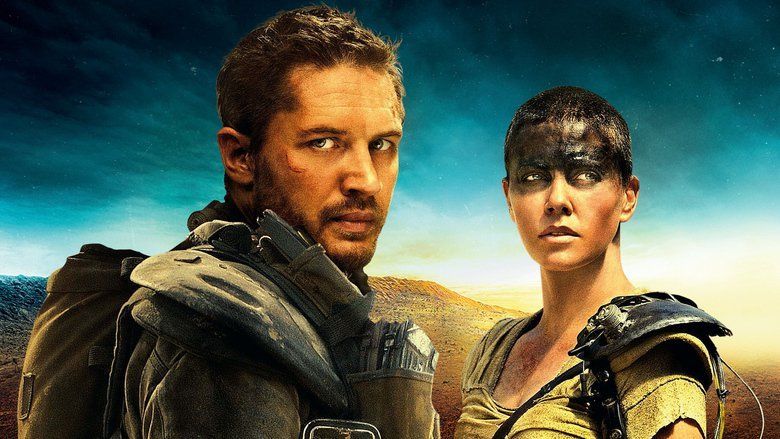
The group heads back to the Citadel, but they are attacked en route by Joe's forces, and Furiosa is seriously wounded. Joe positions his car in front of the War Rig to slow it, while Max fights Joe's giant son, Rictus Erectus. Joe captures Toast, who manages to distract him long enough for Furiosa to kill him. Nux sacrifices himself by wrecking the Rig, killing Rictus and blocking the canyon, allowing Max, Furiosa, the wives, and the surviving Vuvalini to escape in Joe's car, where Max transfuses his blood to Furiosa, saving her life.
At the Citadel, the impoverished citizens react to Joe's death with joy. Furiosa, the wives, and the Vuvalini are cheered by the people and welcomed by the remaining War Boys. Max shares a respectful glance with Furiosa before blending into the crowd and again departing for parts unknown.
Survival
The primary theme of Mad Max: Fury Road is survival, in particular, the survival of humanity in the face of apocalyptic circumstances. The struggle to maintain one's humanity is illustrated as Max begins the film a feral wanderer seeking only to survive, but his partnering with Furiosa allows both of them to rediscover the common dignity that makes them human. As the underlying goal for Max, the theme of staying alive has been carried over from the previous installments of the series that also highlight issues such as ecological collapse and moral decadence. "Survival is key", explained Miller. "I think it's a reason why the American Western was such a staple for the better part of a century in American cinema. They were allegorical tales with figures in the landscape working these things out".
Other themes
Further themes pointed out by critics have included vengeance, solidarity, home, and redemption. In his review of Mad Max: Fury Road, film critic A. O. Scott wrote: "The themes of vengeance and solidarity, the wide-open spaces and the kinetic, ground-level movement mark Fury Road as a western, and the filmmakers pay tribute to such masters of the genre as John Ford, Budd Boetticher and, not least, Chuck Jones, whose Road Runner cartoons are models of ingenuity and rigor." Similar to the previous Mad Max films, home has been regarded as a central theme in Mad Max: Fury Road as it dominates the motivations of Max, Furiosa, and the Five Wives: his home was destroyed, she was taken from her home, and the wives are in search of a new home to raise their children. The unity of these characters also harnesses a concern for family, a common theme within Miller's filmography. It also carries the theme of female empowerment.
Control is another prominent theme in the film, with fluids particularly representing this aspect. Immortan Joe controls the water needed for survival, as well as his Wives' breast milk and the blood of his prisoners (including Max).
Feminism
Feminism is another theme that has received notice. Charlize Theron is a "dramatic center for the film." Throughout the film, her character demonstrates the physicality of a hero committed to a rescue mission. Another indicator of the feminist theme is "in the end, the movie...sets up the start of a matriarchal society as an antidote to the barbarian, warlike tribes that came before". These elements contrast this film with the male-centered hero in the Mad Max films that came before.
Theron's character, Furiosa, "has a shaved head..a fierce leather outfit..a mechanical arm she jerry-rigged from salvaged tools," and "is a sharpshooting powerhouse who can also handle an 18-wheel war rig charging through the desert." She is "a female road warrior." Throughout the film, Furiosa "is a character exactly equal to Max." Furiosa and Max are presented as protagonist/antagonist.
Kyle Smith of the New York Post said that the title character, Mad Max, is "actually a secondary figure" in a film that is not about a roaming Max Rockatansky. Instead, the movie is "actually" about a "feminist revolt led by Imperator Furiosa" against Immortan Joe.
Development
Plans for a fourth film in the Mad Max series hit financial difficulties and the project spent several years in "development hell". In 1995, George Miller re-acquired the rights to future Mad Max films from Warner Bros. The idea for a fourth instalment occurred to Miller in August 1998 when he was walking in an intersection in Los Angeles. About a year later, while travelling from Los Angeles to Australia, the idea coalesced. Miller conceived a story where "violent marauders were fighting, not for oil or for material goods, but for human beings." The film was set to shoot in 2001 through 20th Century Fox, but was postponed because of the September 11 attacks that same year. "The American dollar collapsed against the Australian dollar, and our budget ballooned", Miller said, adding that he "had to move on to Happy Feet because there was a small window when that was ready". Mel Gibson, who starred in the original three previous films, would not return to his role as the lead character. Miller ended up re-casting the role because of controversies surrounding Gibson and because he wanted Max to remain at a younger age, as the "same contemporary warrior". Miller announced in 2003 that a script had been written for a fourth film, and that pre-production was in the early stages. The project was given the green light to begin filming in the Australian desert in May 2003 with a budget of US$100 million, but the location was ruined by rainfall. Mad Max 4 entered then a hiatus in light of security concerns related to its Namibian shoot because of tightened travel and shipping restrictions at the onset of the Iraq War.
In November 2006, Miller stated that he intended to make Fury Road and that the film was never going to involve Gibson: "There's a real hope. The last thing I wanted to do is another Mad Max, but this script came along, and I'm completely carried away with it." The film's screenplay was co-written with cult British comic creator Brendan McCarthy, who also designed many of the new characters and vehicles. Miller again confirmed his intention to make another Mad Max at the 2007 Aurora filmmaker initiative. However, he stated that he thought Gibson would not be interested in the film because of his age. Heath Ledger was reportedly considered for the lead before his death in 2008. On 5 March 2009, it was announced that an R-rated 3D animated feature film was in pre-production and would be taking much of the plot from Fury Road, although Gibson would not be in the film and Miller was looking for a "different route", a "renaissance" of the franchise. Miller cited director Akira Kurosawa as an inspiration for what he wanted to do with the franchise. Miller was also developing an action-adventure tie-in video game based on the fourth film, along with God of War II video game designer Cory Barlog. Both projects were expected to take two to two-and-a-half years, according to Miller, with a release date of either 2011 or 2012. Fury Road was going to be produced at Dr. D Studios, a digital art studios founded in 2008 by Miller and Doug Mitchell.
On 18 May 2009, it was reported that location scouting was underway for Mad Max 4. After exploring the possibility of an animated 3D film, Miller decided instead to shoot a 3D live action film. By this time, production had moved to Warner Bros. In October 2009, Miller announced that principal photography on Fury Road would commence at Broken Hill, New South Wales in early 2011, ending years of speculation. This announcement attracted widespread media attention in Australia, with speculation on whether Gibson would return as Max. That same month, British actor Tom Hardy was in negotiations to take the lead role of Max, while it was also announced that Charlize Theron would play a major role in the film. In June 2010, Hardy announced on Friday Night with Jonathan Ross that he would play the title role. In July 2010, Miller announced plans to shoot two Mad Max films back-to-back, entitled Mad Max: Fury Road and Mad Max: Furiosa. Weta Digital was originally involved with the film when it was scheduled for a 2012 release. The company was to be handling visual effects, conceptual designs, speciality make-up effects, and costume designs until production was postponed from its November 2010 start date.
In November 2011, filming was moved from Broken Hill back to Namibia, after unexpected heavy rains caused wildflowers to grow in the desert, inappropriate for the look of the film. Other potential locations scouted included the Atacama Desert in Chile, Chott el Djerid in Tunisia, and Azerbaijan.
In a July 2014 interview at San Diego Comic-Con International, Miller said he designed the film in storyboard form before writing the screenplay, working with five storyboard artists. It came out as about 3,500 panels, almost the same number of shots as in the finished film. He wanted the film to be almost a continuous chase, with relatively little dialogue, and to have the visuals come first. Paraphrasing Alfred Hitchcock, Miller said that he wanted the film to be understood in Japan without the use of subtitles.
Filming
Principal photography began on 26 June 2012 in Namibia. Filming also took place at Potts Hill and Penrith Lakes in Western Sydney. In October 2012, The Hollywood Reporter reported that Warner Bros. sent an executive to keep the production on track. Filming wrapped on 17 December 2012 and lasted for 120 days. In February 2013, a leaked draft from the Namibian Coast Conservation and Management group accused the producers of damaging parts of the Namib Desert, endangering a number of plant and animal species. However, the Namibia Film Commission said it had "no reservations" after visiting the set during production. It disputed claims reported in the media, calling the accusations "unjust rhetoric". In September 2013, it was announced that the film would undergo reshoots in November 2013.
Miller said that he did not feel he had to top himself in terms of production design compared to the previous films in the series. Instead, he wanted the production design to harken back to the earlier films and reflect the changes of the past 30 years. Colin Gibson, the production designer, said that they developed an internally consistent history to explain the film's look and justify its use of hot rods. Gibson designed the film's vehicles, all of which are fully functional. Construction of some of the vehicles began as early as 2003. The cars were designed to show characterisation and detail in the world, including the characters' feelings of guilt, loss, and their attempts to recycle the remains of civilisation. Both the Doof Wagon and the Doof Warrior's guitar are fully functional – none of his scenes were rendered in CGI.
Cinematographer John Seale came out of retirement to shoot Fury Road. He replaced Dean Semler, the cinematographer of the previous two films, after Semler left. Seale outfitted his camera crew with six Arri Alexa Pluses and four Alexa Ms, as well as a number of Canon EOS 5Ds and Olympus PEN E-P5s that were used as crash cams for the action sequences. It was the first time Seale shot with digital cameras. Because of the fast nature required for edits, Miller asked Seale to keep the focus of the shot centered for each scene, thus allowing the audience to quickly orient towards it.
In July 2014, director George Miller described the film as "a very simple allegory, almost a western on wheels". Miller said that 90% of the effects were practical. Second unit director and supervising stunt coordinator Guy Norris was in charge of over 150 stunt performers, which included Cirque du Soleil performers and Olympic athletes. Miller invited playwright Eve Ensler to act as an on-set adviser. Impressed with the script's depth and what she saw as feminist themes, she spent a week in Namibia, where she spoke to the actors about issues of violence against women.
Post-production
Mad Max: Fury Road contains 2,000 visual effects shots. The lead effects company was Iloura, who delivered more than 1,500 effects shots for the film. Additional visual effects studios that worked on the film include Method Studios, Stereo D, 4DMax, BlackGinger, The Third Floor, and Dr. D Studios. Miller recruited his wife, Margaret Sixel, to edit the film, as he felt she could make it stand out from other action films. Sixel had 480 hours of footage to edit; watching it took three months. The film contains about 2,700 cuts of its entire running length, which is equivalent to 22.5 cuts per minute compared to The Road Warrior's 1,200 cuts of its 90-minute running time equivalent to 13.33 cuts per minute. The frame rate was also manipulated. "Something like 50 or 60 percent of the film is not running at 24 frames a second, which is the traditional frame rate," said Seale. "It'll be running below 24 frames because George, if he couldn't understand what was happening in the shot, he slowed it down until you could. Or if it was too well understood, he'd shorten it or he'd speed it up back towards 24. His manipulation of every shot in that movie is intense." The Washington Post would later note that the changing frame rate gave the film an "almost cartoonishly jerky" look.
The extensive effects work included altering lighting and time of day, weather effects, terrain replacement and plate composition. Night scenes were filmed in bright daylight, deliberately overexposed and colour-manipulated. In many shots, the sky was digitally replaced with more detailed or interesting skies. Charlize Theron wore a green cover over her left arm to aid effects artists in digitally removing her arm from her scenes. BAFTA-winning costume designer Jenny Beavan said "As far as I know, the only VFX on our costume was the green glove Charlize wore to hide her arm and they also took out wires from the harnesses. Otherwise, every costume is what it is. It’s costume. It’s their clothing. It’s just made for real! Oh yes and some of the extras – the wretched – they were enhanced. Only for the wide shots."
Sound designer Mark Mangini stated that he viewed the War Rig as an allegory for Moby-Dick with Immortan Joe playing the role of Captain Ahab. As such, the mechanical truck sounds were layered with whale calls to provide a more animal-like quality to the truck. When the tank is pierced with harpoons and milk sprays out, the sound of whale blow-holes were used. For the final destruction of the War Rig, the only sounds used were slowed down bear growls to symbolise the death of the truck as a living creature.
Both a PG-13 and R-rated version had been shown separately in different test screenings. The R-rated version was better received by test audiences, leading Warner Brothers to release it.
Music
The musical score for Mad Max: Fury Road was written by the Dutch composer Junkie XL. Prior to Junkie XL's involvement, Hans Zimmer, John Powell and Marco Beltrami were attached at separate times to score the film. After hearing Junkie XL's score for 300: Rise of an Empire, Miller met with the composer in Sydney. "I got very inspired and started writing pieces of music for scenes," said Junkie XL. "The initial main themes were written in the four weeks after that first meeting and those themes never changed." A soundtrack album was released by WaterTower Music on 12 May 2015.
Release
A deluxe edition hardcover collection of art titled Mad Max: Fury Road - Inspired Artists Deluxe Edition inspired by the film was released on 6 May 2015. Mad Max: Fury Road had its world premiere on 7 May 2015 at the TCL Chinese Theatre in Los Angeles. On 14 May 2015, it screened out-of-competition at the 68th Cannes Film Festival, and then was released in theatres on 15 May 2015. Leading up its release, the film was digitally re-mastered into the IMAX 3D format. It was released into IMAX theatres in select international territories on 13 May 2015. It also received a one-week only IMAX 3D re-release in America starting 11 September 2015. Warner Bros. spent a total of $43.7 million on advertisement for the film. It was re-released in India on March 11, 2016 in 3D and IMAX 3D. Fury Road was however never granted a release in China, the world's second biggest movie market, due to its intense nature, but it was almost immediately available for legal streaming on various online platforms.
Prequel comics
In May 2015, Vertigo began publishing a comic book prequel limited series. Each issue focuses on the backstory of one or two of the film's characters. The first issue, titled Mad Max: Fury Road - Nux and Immortan Joe #1, was released on 20 May. The second, Mad Max: Fury Road - Furiosa #1, was released on 17 June. The third, Mad Max: Fury Road - Mad Max #1, was released on 8 July. The final issue, Mad Max: Fury Road - Mad Max #2, was released on 5 August. A single-volume collection containing the stories of all four issues was released on 26 August.
Home media
Miller stated that the Blu-ray Disc release would include black-and-white and silent versions of the film, with the latter accompanied by the musical score. Miller described the black-and-white cut as the best version of the film. However, when details for both the United Kingdom and United States releases of the Blu-ray were announced, the alternate cuts were absent. Producer Doug Mitchell in December 2015 confirmed that the black and white version existed and could potentially see a future theatrical release. In January 2016, Miller announced the black-and-white versions would appear in another DVD release.
The film was released on Blu-ray and DVD in the United Kingdom on 5 October 2015. In the United States, the film was released digitally on 11 August 2015, and physically on 1 September. In addition to the stand-alone release, a box set containing all four films and a documentary about the series titled "Madness of Max" was released the same day. In October 2016, the black and white version of Fury Road, called Mad Max: Black & Chrome debuted in the Mad Max: High Octane anthology; a stand-alone version of the film was also available for streaming at the same time and was released on physical media on December 6, 2016.
Box office
Mad Max: Fury Road became a moderate box office success theatrically. When comparing the final theatrical gross to its $200 million budget (including production, marketing and distribution costs), it was an average hit, with Forbes comparing the box office figures of the film to Edge of Tomorrow, calling it "too expensive, but not really a flop." The Hollywood Reporter calculated that the loss incurred by the film was around $20–40 million. According to Forbes, one of the reasons the film emerged less successful than hoped was its cancelled release in China; success there could have aided the film in at least passing $400 million. It grossed $153.6 million in North America and $224.8 million in other territories for a worldwide total of $378.4 million. It had a worldwide opening weekend total of $109 million, and went on to become the second highest-grossing Warner Bros. film of 2015 (behind San Andreas), and the nineteenth highest-grossing film of 2015 worldwide overall.
In the United States and Canada, Mad Max: Fury Road opened simultaneously with Pitch Perfect 2. It opened Friday, 15 May 2015, across 3,702 theatres, and earned $16.77 million on its opening day. This included $3.7 million it made from Thursday night run from 3,000 theatres. In its opening weekend, the film grossed $45.4 million, finishing in second at the box office behind Pitch Perfect 2 ($69.2 million). Mad Max: Fury Road, unlike the other seven 2015 Academy Award for Best Picture nominees, became the only film which did not get any box office bump after the nominees were announced in January 2016. However, Fury Road was released eight months prior to the announcement and had ended its theatrical run on September 24, 2015.
Outside North America, it opened on 14 May on 12,000 screens in 48 countries, earning $10.4 million. It opened in 20 more countries on 15 May, earning $14.2 million from 16,700 screens in 68 countries, for a two-day total of $24.6 million. Through Sunday, 17 May, it had an opening weekend total of $65 million from over 9.1 million admissions on nearly 16,900 screens across 68 countries, debuting at second place behind Avengers: Age of Ultron. It went number one in 40 countries. Its highest openings were recorded in the UK ($7 million), South Korea ($6.6 million), France ($6.1 million), Russia and the CIS ($6 million) and Australia ($4.9 million). It opened in its last market, Japan, on June 20, earning $2.2 million from 175,000 admissions in its opening weekend debuting at No. 2 behind local film Love Live! The School Idol Movie. In total earnings, its three largest markets outside of the US and Canada are South Korea ($29.7 million), followed by the UK ($26.9 million) and France ($18.1 million).
Critical reception
Mad Max: Fury Road received widespread critical acclaim. Review aggregator website Rotten Tomatoes gives the film a 97% approval rating and rating average score of 8.6 out of 10 based on 366 reviews. The site's consensus reads, "With exhilarating action and a surprising amount of narrative heft, Mad Max: Fury Road brings George Miller's post-apocalyptic franchise roaring vigorously back to life." On Metacritic, which assigns a normalised rating, the film has a score of 90 out of 100 based on 51 critics, indicating "universal acclaim". CinemaScore polls reported that the average grade cinema audiences gave the film was a "B+" on an A+ to F scale. Some critics have named Mad Max: Fury Road one of the greatest action films ever made.
Robbie Collin of The Daily Telegraph gave the film a full five stars and praised the film for its acting, screenplay, choreography, stunts, humor, and direction calling the film a "spiritual sequel" and an "eruption of craziness." Writing for The Guardian and awarding the film four stars out of five, Peter Bradshaw wrote, "Extravagantly deranged, ear-splittingly cacophonous, and entirely over the top, George Miller has revived his Mad Max punk-western franchise as a bizarre convoy chase action-thriller in the post-apocalyptic desert." The New York Times wrote, "Miller has reminded us that blockbusters have the potential to not only be art, but radically visionary – even the fourth in a series. What a lovely day, indeed." Scott Mendelson of Forbes gave the film 10 out of 10 stars and wrote, "Mad Max: Fury Road is a remarkable and glorious motion picture, not just one of the great action movies of our time but also a great and timely film, period." Alonso Duralde of TheWrap wrote, "In the same way that the original 1979 Mad Max was the Citizen Kane of gut-bucket Australian exploitation cinema, Mad Max: Fury Road may well be the Götterdämmerung of drive-in movies. It has its roots in the Western and the post-apocalyptic road-rage action saga [...], where Miller dares anyone else to follow in his tire treads." IGN reviewer Scott Collura gave the film 9.2 out of 10, saying: "The over-the-top stunts and eccentric characters and designs are all hugely important to Fury Road, ... but it's the overriding sense of the film's uniqueness, its striving to be something more than just another action movie, that is most impressive."
The film has also been praised by scholars on several fronts. Feminist critics have praised the dominant role taken by Furiosa and the range of atypical female roles including the wives and the gun-toting Vuvalini, and disability studies scholars have commended the film for its positive, non-stigmatizing portrayals of physical and psychological disabilities.
Mad Max: Fury Road was later named the nineteen-greatest film of the 21st century in a 2016 BBC critics' poll.
In 2017, it was named the nineteenth "Best Film of the 21st Century So Far" by The New York Times.
Accolades
Mad Max: Fury Road was named one of the best films of 2015 by numerous critics and publications, including ranked first on the rogerebert.com Ten Best Films of 2015, and was ranked first on Metacritic and Rotten Tomatoes's best scored film of 2015.
The film won many critical and guild awards, and received ten Academy Award nominations, including Best Picture and Best Director, the second most-nominated film of the 88th Academy Awards after The Revenant, also starring Hardy. It is the first film of the Mad Max franchise to receive Academy Award recognition, and one of the few sequels to be nominated for Best Picture. The film won six Academy Awards for Best Film Editing, Best Production Design, Best Costume Design, Best Makeup and Hairstyling, Best Sound Mixing and Best Sound Editing, surpassing all other films at the awards ceremony, and broke the record for the most wins for an Australian film, previously held by The Piano (1993), which won three Oscars.
Sequels
In 2011, Miller and McCarthy found during the writing process for Fury Road that they had enough story material for two additional scripts. One of these, entitled Mad Max: Furiosa, had already been completed, and Miller hoped to film it after the release of Fury Road. In March 2015, during an interview with Esquire, Hardy revealed that he was attached to star in three more Mad Max films following Fury Road. In May 2015, Miller told Wired: "Should Fury Road be successful, I've got two other stories to tell." Later in May, Miller revealed that plans for the sequel had changed and the fifth film in the franchise will instead be titled Mad Max: The Wasteland. In October 2015, Miller revealed in an interview with TopGear.com that they had two scripts for sequels which they ended up with during the writing process. Later that month, he clarified that Mad Max: The Wasteland was a working title for the sequel. Miller reaffirmed his intent to continue the franchise after reports to the contrary surfaced following an interview in January 2016.
References
Mad Max: Fury Road WikipediaMad Max: Fury Road IMDbMad Max: Fury Road Rotten TomatoesMad Max: Fury Road MetacriticMad Max: Fury Road LetterboxdMad Max: Fury Road themoviedb.org
